The Classic Airborne Visible and Infrared Imaging Spectrometer (AVIRIS-C) has been flying the HyspIRI CA collections on the NASA ER-2 from Armstrong Palmdale Hangar 703. In the last week collections have occurred over the Santa Barbara Box (June 8), Southern CA Box (June 12), Yosemite Box (June 6) and Bay Area Box (June 13). The Santa Barbara Box will need to be recollected due to cloud cover. The Associate Administrator, Dr. Thomas Zurbuchen, visited the HyspIRI deployment on Friday, June 8.
The King Air and AVIRIS-NG flew targets on Tuesday, June 13, and then headed West towards Saint Louis for an overnight before traveling to Burbank on Wednesday, June 14. There will be local flights from Burbank as part of the CA Methane Survey this week.




